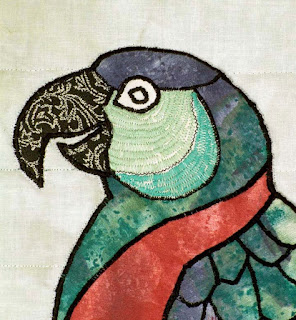 |
| St. Lucia. An art quilt. 37" x 46" |
To go to the beginning of this book, Tropic Moon: Memories, click HERE.
We left
Bermuda in mid-June. Another week of sailing, and we would reach our
destination on Long Island, New York. Some people assume that
sailing north from the Caribbean means hugging the Eastern U.S. coast - it
doesn't. We were well out to sea, 1000 miles east of Florida, and (at our
closest), 650 miles east of Cape Hatteras, North Carolina, when we passed
that latitude.
We saw
birds throughout the trip, and were visited once by dolphins that were
traveling south, but our main "company" came from the voices that
were audible throughout the passage. We’d heard them on the trip from the
Virgins to Bermuda, and now they were with us again.
 |
| St. Lucia. Detail. |
Sounding
like both male and female in tone, the voices constantly chattered, sometimes
letting out a laugh or a yell, but never distinct enough for us to pick up any
words. We could hear them throughout the boat. At first we were continually asking each other, "What did
you say?" At one point I was on my bunk and Ed was in the galley. He came in to take my hand and ask me
what was wrong. Why was I crying?
I hadn't been making any sound at all.
Eventually,
I discovered the source of the voices.
I was sitting on the head, one foot braced against the back of the door,
to compensate for the heel of the boat.
The loud chattering was making me nuts.
Without realizing what I was doing, I slapped my hand against the
overflow hole in the sink. The voices
quieted substantially. It was one of
those Oh-My-God moments. I pushed the
rubber stopper into the sink drain and put my hand back to cover the overflow
hole. Near quiet…
 |
| St. Lucia. Detail. |
Tropic
Moon had three sinks. One in the head,
and a large, deep sink in the galley – both of which were midway through the
boat. The third sink was in the aft
cabin (back end of the boat). I went
through Tropic Moon, putting stoppers in the sink drains, and covering the
overflow holes with masking tape. The
source of our voices? Seawater gurgling
in the pipes... Needless to say, Ed was
impressed with my discovery.
We were
happy to reach Long Island, where Ed's parents lived. For the month of
July, we moved ashore into Ed's childhood home in Baldwin, New York. We enjoyed real beds, hot showers, and Ed's
mom's delicious home cooking.






















